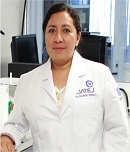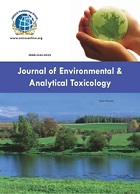Theme: Unique Pioneering Research on Fundamental and Upcoming Environmental Issues
Environmental Chemistry 2017
Environmental chemistry is the study of chemical processes occurring in the environment which are impacted by humankind's activities. These impacts may be felt on a local scale, through the presence of urban air pollutants or toxic substances arising from a chemical waste site, or on a global scale, through depletion of stratospheric ozone or global warming. The focus in our courses and research activities is upon developing a fundamental understanding of the nature of these chemical processes, so that humankind's activities can be accurately evaluated.
The field of environmental chemistry is both very broad and highly interdisciplinary. Within the Department of Chemistry we have a core group of faculty whose research interests are in atmospheric and aquatic chemistry, photochemistry, and the chemistry and transport of long-lived pollutants. We interact with other chemists in the Department, with numerous other researchers at the University who have related interests, and with nearby government agencies. Indeed, the setting for the study of environmental chemistry is ideal.
Track 1: Environmental Chemistry and Engineering
Environmental chemistry is the scientific review of the chemical and biochemical phenomena that occur in natural places. Environmental chemistry can be described as the study of the sources, reactions, transport, effects of chemical species in the air, soil, and water environments; and the effect of human activity on these. Environmental chemistry is an integrative science that includes atmospheric, aquatic and soil chemistry, as well as uses analytical chemistry. It is allied to environmental and other areas of science. It is different from green chemistry, which tries to trim potential pollution at its source.
Whereas Environmental engineering deals with the combination of sciences and engineering principles to develop the natural environment, to provide healthy air, water, and land for human habitation and for other organisms, and to procure pollution sites.
BCC research estimates that the global environmental sensor and monitoring business will grow from $13.2 billion in 2014 to nearly $17.6 billion in 2019, a compound annual growth rate (CAGR) of 5.9% for the period of 2014 to 2019. This report provides information on emerging growth areas, such as large-scale monitoring networks, analyses of global market trends, with data from 2013, estimates for 2014, and projections of compound annual growth rates (CAGRs) through 2019.
Related Conferences:
2nd Pollution Control and Sustainable Environment Conference October 05-06, 2017 London UK; 2nd Global Solar Energy Summit Conference July 10-12, 2017 Madrid, Spain; 6th Coastal Zones Conference July 10-11, 2017 Jakarta, Indonesia; Recycling: Reduce, Reuse, Recycle Conference November 06-08, 2017 Las Vegas ,Nevada, USA; 2nd Nanotechnology and Environmental Issues conference April 5-6, 2017 Barcelona Spain ; Environmental Science and Technology conference August 31 - September 02 2017 Rhodes Island, ; 6th Ecological and Environmental Chemistry conference March 2-3,2017 Chisinau, Republic of Moldova; 5th Multifunctional, Hybrid and Nanomaterial conference March 6-10 2017 Lisbon, Portugal
Related Societies:
Earth System Governance Project (ESGP) Intergovernmental Panel on Climate Change (IPCC); Society of Environmental Toxicology and Chemistry (SETAC) Association of Chemistry and the Environment (ACE)
Track 2: Environmental Biotechnology
Environmental biotechnology is a complex of scientific and engineering education related to the use of microorganisms and their products in the inhibition of environmental pollution through bio treatment of liquid, solid, and gaseous wastes, bioremediation of spoil environments, bio monitoring of environment and treatment processes. The aids of biotechnological treatment of wastes are as follows: diversity of the conditions suitable for biodegradation, biodegradation of a wide spectrum of hazard substances by natural microorganisms; availability of a wide range of biotechnological channels for complete wrecking of hazardous wastes; and diversity of the conditions suitable for biodegradation. The major considerations for utilization of biotechnology in waste treatment are technically and economically reasonable rate of detoxification of substances during biotechnological treatment, and ability of natural microorganisms to degrade substances.
U.S. sales of environmental biotechnology products were valued at $241.2 million in 2012. This is expected to increase at a total compound annual growth rate (CAGR) of 7.9%, with 2013 sales of $261.9 million, rising to $382.3 million in 2018.
Related Conferences:
6th Ecology and Ecosystems Conference September 18-20, 2017 Toronto, Canada; Earth Science and Climate Change Conference September 18-19, 2017 Macau, Hong Kong; 4th Green Energy & Expo Conference November 06-08, 2017 Las Vegas, Nevada, USA; Natural Hazards and Disaster Management Conference June 01-03, 2017 Osaka, japan; 8th Environmental Science and Technology Conference June 12-14, 2017 Spain, Madrid; Water, Informatics, Sustainability and Environment conference July 03 – 05, 2017 Ottawa, Canada; Energy and Environmental Science conference January 22-2017 Bangkok, Thailand; Ecological & Environmental Chemistry conference March 02-03 2017 Chisinau, Moldova
Related Societies:
Earth System Governance Project (ESGP) Intergovernmental Panel on Climate Change (IPCC); Society of Environmental Toxicology and Chemistry (SETAC) Association of Chemistry and the Environment (ACE)
Track 3: Pollution Control Chemistry and Green Chemistry
Green chemistry is the design of chemical products and processes that reduce or eliminate the use or generation of hazardous substances. Green chemistry applies across the life cycle of a chemical product, including its design, manufacture, use, and ultimate disposal. Green chemistry is also known as sustainable chemistry. Green chemistry reduces pollution at its source by minimizing or eliminating the hazards of chemical feed stocks, reagents, solvents, and products.
The global market for air pollution control equipment reached nearly $56.6 billion and $61 billion in 2013 and 2014, respectively. This market is expected to grow at a compound annual growth rate (CAGR) of 5.2% to $78.4 billion for the period 2014-2019. This report provides in-depth analysis of the global markets and technologies for air pollution control equipment.
Related Conferences:
7th Biofuels and Bioenergy Conference October 2-4, 2017 Toronto, Canada; Renewable Energy and Resources Conference July 24-25, 2017 Vancouver ,Canada; 5th Sustainable Bio plastics Conference July 20-21, 2017 Munich, Germany; 2nd Biodiesel Congress & Expo Conference 04-05, 2017 Atlanta, Georgia, USA; 3rd Environment and Renewable Energy Conference February 25-27, 2017 at Hanoi, Vietnam; Bio-Signal and Image Processing Conference July 22-24, 2017 Budapest, Hungary; Molecular Biology and Bioinformatics Conference July. 22-24, 2017 Budapest, Hungary; 2nd Green Energy Technology Conference July 18-20, 2017 Rome, Italy
Related Societies:
Earth System Governance Project (ESGP) Intergovernmental Panel on Climate Change (IPCC); Society of Environmental Toxicology and Chemistry (SETAC) Association of Chemistry and the Environment (ACE)
Track 4: Environmental Toxicology and Mutagenicity
Environmental toxicology is the science and practice of the adverse effects mainly of chemicals other man-made agents in the environment and through the environment. The targeted receptors of these adverse effects may be both the ecosystem and the human. Environmental toxicology includes the study of chemical substances potential and actual contaminants – polluting air, water, soil and food, their impacts upon the structure and function of ecological systems, including man as well as the use of these results for decision making and environmental management.
Mutagenicity refers to the induction of permanent transmissible changes in the structure of the genetic material of cells or organisms. These changes (mutations) may involve a single gene or a block of genes.
The global in vitro toxicity testing market was valued at $4 billion in 2011 and more than $4.9 billion in 2012. This market is estimated to reach nearly $9.9 billion in 2017, with a compound annual growth rate (CAGR) of 14.7% for the five-year period, 2012 to 2017. This report provides an overview of the global in vitro toxicity testing market, with assessments of its growth potential over the next five years and the current market scenario for alternative measures to animal testing.
Related Conferences:
6th Biopolymers Conference 07-09, 2017 Paris, France; 2nd Euro Global Summit and Expo on Biomass Conference October 12-13, 2017 London, UK; 2nd Green and Sustainable Chemistry Conference May 14 – 17, 2017 Intercontinental Berlin, Germany; Molecular Biology and Bioinformatics Conference July. 22-24, 2017Budapest, Hungary; 2nd Green Energy Technology Conference July 18-20, 2017 Rome, Italy; Materials Sciences and Nano materials Conference July 14-16, 2017Barcelona, Spain; Conference on Advanced Manufacturing and Materials Conference June. 25-27, 2017Hong Kong
Related Societies:
Earth System Governance Project (ESGP) Intergovernmental Panel on Climate Change (IPCC); Society of Environmental Toxicology and Chemistry (SETAC) Association of Chemistry and the Environment (ACE)
Track 5: Energy and Environment
Energy and environment are related in the technological and scientific aspects including energy conservation, and the synergy of energy forms and systems with the physical environment. The levels of atmospheric carbon dioxide has risen by 31% between 1800 and 2000, going from 280 parts per million to 367 parts per million. Scientists predict that co2 levels could be as high as 970 parts per million by the year 2100. Different factors are responsible for this development, such as promotion with respect to technical parameters of energy converters, in particular, improved efficiency; discharge characteristics and increased lifetime. Various environmental policies have been implemented across the world for reduction of GHG emissions for improvement of environment.
The global market for energy and environmental catalysts totaled $25.7 billion in 2014. This market is expected to grow at a compound annual growth rate (CAGR) of 5.6%, from nearly $27.3 billion in 2015 to nearly $35.8 billion by 2020
Related Conferences:
6th Ecology and Ecosystems Conference September 18-20, 2017 Toronto, Canada; Earth Science and Climate Change Conference September 18-19, 2017 Macau, Hong Kong; 4th Green Energy & Expo Conference November 06-08, 2017 Las Vegas, Nevada, USA; Disaster and Management Conference June 01- 03, 2017 Osaka, japan; 2nd Green Energy Technology Conference July 18-20, 2017 Rome, Italy; Materials Sciences and July 14-16, 2017 Barcelona, Spain; Conference on Advanced Manufacturing and Materials Conference June. 25-27, 2017Hong Kong; 6th Petroleum Industry and Energy Conference June 12-14, 2017Madrid, Spain
Related Societies:
Earth System Governance Project (ESGP) Intergovernmental Panel on Climate Change (IPCC); Society of Environmental Toxicology and Chemistry (SETAC) Association of Chemistry and the Environment (ACE)
Track 6: Applications of Environmental Chemistry
Environmental chemistry application areas:
- Risk/Hazard Assessments and Environmental Impact Assessments
- Environmental Management
- Groundwater protection
- Surface water quality protection
- Soil protection
- Cleaner production and waste management Policy
Related Conferences:
2ndBiodiesel Congress & Expo Conference 04-05, 2017 Atlanta, Georgia, USA; 6th Biopolymers Conference 07-09, 2017 Paris, France; 2nd Euro Summit and Expo on Biomass Conference October 12-13, 2017 London, UK; . 2nd Green and Sustainable Chemistry Conference May 14 – 17, 2017 Intercontinental Berlin, Germany; 3rd Food and Environmental Sciences Conference February 25-27, 2017Hanoi, Vietnam; 7th Environment and Industrial Innovation Conference April 24-26, 2017Kuala Lumpur, Malaysia; 4th Geological and Civil Engineering Conference January. 08-10, 2017Penang, Malaysia; Ontario Geothermal Association Conference February 21-22, 2017 Mississauga, Canada
Related Societies:
Earth System Governance Project (ESGP) Intergovernmental Panel on Climate Change (IPCC); Society of Environmental Toxicology and Chemistry (SETAC) Association of Chemistry and the Environment (ACE)
Track 7: Environmental Design
Environmental design is the manner of addressing surrounding environmental parameters when devising plans, policies, programs, buildings, or products.
Environmental design can also refer to the applied arts and sciences dealing with creating the human-designed environment. These fields constitute architecture, geography, urban planning, landscape architecture, and interior design. Environmental design can also encircle interdisciplinary areas such as historical preservation and lighting design. In terms of a bigger scope, environmental design has implications for the industrial design of products: wind-electricity generators, innovative automobiles, solar-electric equipment, and other kinds of equipment could serve as examples. Currently, the term has expanded to employ wind-electricity generators to ecological and sustainability issues.
The global market for environmental remediation technologies was valued at about $59.5 billion in 2013. The total market is expected to expand from nearly $61.7 billion in 2014 to $80.5 billion in 2019, with a compound annual growth rate (CAGR) of 5.5% from 2014 through 2019
Related Conferences:
Green and Sustainable Chemistry Conference May 14 – 17, 2017. Intercontinental Berlin, Germany; 6th Ecology and Ecosystems Conference September 18-20, 2017 Toronto, Canada; 7th Biofuels and Bioenergy Conference October 2-4, 2017 Toronto, Canada; 2nd Solar Energy Conference July 10-12, 2017 Madrid, Spain; 2nd Nanotechnology and Environmental Issues conference April 5-6, 2017 Barcelona, Spain ; Environmental Science and Technology conference August 31 - September 02 2017 Rhodes Island, Greece; 6th Ecological and Environmental Chemistry conference March 2-3,2017 Chisinau, Republic of Moldova; 5th Multifunctional, Hybrid and Nanomaterial conference March 6-10 2017 Lisbon, Portugal
Related Societies:
Earth System Governance Project (ESGP) Intergovernmental Panel on Climate Change (IPCC); Society of Environmental Toxicology and Chemistry (SETAC) Association of Chemistry and the Environment (ACE)
Track 8: Environmental Hazards
Environmental hazards may be chemical, physical, biological, biomechanical or psychosocial in nature. Environmental hazards build traditional risks of poor sanitation and shelter, as well as agricultural and industrial contamination of air, water, food, land. Environmental health risks result from people interacting with hazards in the surrounding environment.
In order to prevent environmental hazards affecting our health, it is very important to be aware of the hazards and to take steps to supervise the risks. Some majorly deals with general environmental health hazards, and not extremes of climate, chemical hazards, occupational hazards, physical hazards and hazards associated with food also may be the reason.
The global market for hazardous waste management reached $23.8 billion in 2013 and nearly $25.9 billion in 2014. This market is expected to grow to nearly $33.9 billion in 2019, with a compound annual growth rate (CAGR) of 5.5%
Related Conferences:
Earth Science and Climate Change Conference September 18-19, 2017 Macau, Hong Kong; .4th Green Energy & Expo Conference November 06-08, 2017 Las Vegas, Nevada, USA; Natural Hazards and Disaster Management Conference June 01-03, 2017 Osaka, japan; and Resources Conference July 24-25, 2017 Vancouver, Canada; Bio-Signal and Image Processing Conference July 22-24, 2017 Budapest, Hungary; Molecular Biology and Bioinformatics Conference July. 22-24, 2017Budapest, Hungary; Energy Technology Conference July 18-20, 2017 Rome ,Italy; Advanced Manufacturing and Materials Conference June. 25-27, 2017Hong Kong
Related Societies:
Earth System Governance Project (ESGP) Intergovernmental Panel on Climate Change (IPCC); Society of Environmental Toxicology and Chemistry (SETAC) Association of Chemistry and the Environment (ACE)
Track 9: Chemical and Polymer Engineering
Polymer engineering is an engineering that designs analysis and modify polymer material. Basic divisions of polymer are thermoplastic, elastomer, and thermoset which helps to design areas of application compounding and processing of polymer are major description of polymer. It includes different types of polymerization. The special technical importance of polymers can be judged by the fact that half of the professional organic chemists employed by industry in the United States are engaged in research or development related to polymers.
Related Conferences:
6th Ecology and Ecosystems Conference September 18-20, 2017 Toronto, Canada; 2nd Euro Global Summit and Expo on Biomass Conference October 12-13, 2017 London, UK; 6th Biopolymers Conference 07-09, 2017 Paris, France; 2nd Biodiesel Congress & Expo Conference 04-05, 2017 Atlanta, Georgia, USA; 6th Petroleum Industry and Energy Conference June 12-14, 2017 Madrid, Spain; 3rd Food and Environmental Sciences Conference February 25-27, 2017 Hanoi, Vietnam; 7th Environment and Industrial Innovation Conference April 24, 2017;4th Food Security and Nutrition Conference March 13-15, 2017Prague, Czech Republic
Related Societies:
Earth System Governance Project (ESGP) Intergovernmental Panel on Climate Change (IPCC); Society of Environmental Toxicology and Chemistry (SETAC) Association of Chemistry and the Environment (ACE)
Track 10: Environmental Management and Policy
This Area reviews the origins and nature of environmental challenges facing society through the study of their scientific, socio-economic and political dimensions, and prospect the ways of addressing these challenges through environmental, natural resource management, conservation and policy approaches. It is concerned with existing and emerging strategies for avoiding and managing the impacts of human activities and for conserving the resources of the biosphere in ways that are supporting to sustainable development. It provides knowledge, concepts, and skills needed to be effective in environmental management in business, government, and not-for-profit sectors.
Related Conferences:
4th Green Energy & Expo Conference November 06-08, 2017 Las Vegas, Nevada, USA; Renewable Energy and Resources Conference July 24-25, 2017 Vancouver, Canada; 2nd Euro Global Summit and Expo on Biomass Conference October 12-13, 2017 London, UK; 6th Coastal Zones Conference July 10-11, 2017 Jakarta, Indonesia; Water, Informatics, Sustainability and Environment conference July 03 – 05, 2017 Ottawa, Canada; Molecular Biology and Bioinformatics Conference July. 22-24, 2017Budapest, Hungary; 4th Food Security and Nutrition Conference March 13-15, 2017 Prague, Czech Republic; Environmental Science and Technology conference August 31 - September 02 2017 Rhodes Island Greece
Related Societies:
Earth System Governance Project (ESGP) Intergovernmental Panel on Climate Change (IPCC); Society of Environmental Toxicology and Chemistry (SETAC); Association of Chemistry and the Environment (ACE)
Track 11: Environmental Biology
Environmental Biology is the study of organism’s interaction with the environment, and how they adapt to changing environments. It explores the interconnections among biology, ecology, evolution, and conservation. Environments consist of many components including both physical features, such as climate and soil type, and biological features, such as prey and predators. The term environmental biology has wider connotations than ecology because it includes the study of humans in the environment, so you will find such subjects as agriculture, pollution and the unnatural surroundings. Understanding the ecology of an area is like trying to put together a gigantic, multidimensional jigsaw. Some pieces are the individual species in the area.
Related Conferences:
Earth Science and Climate Change Conference September 18-19, 2017 Macau, Hong Kong; Natural Hazards and Disaster Management Conference June 01-03, 2017 Osaka japan; Renewable Energy and Resources Conference July 24-25, 2017 Vancouver ,Canada; 2nd World Biodiesel Congress & Expo Conference 04-05, 2017 Atlanta, Georgia, USA; 6th Ecological and Environmental Chemistry conference March 2-3,2017 Chisinau, Republic of Moldova; Bio-Signal and Image Processing Conference July 22-24, 2017 Budapest, Hungary Conference on Advanced Manufacturing and Materials Conference June. 25-27, 2017Hong Kong; 6th Petroleum Industry and Energy Conference June 12-14, 2017Madrid, Spain
Related Societies:
Earth System Governance Project (ESGP) Intergovernmental Panel on Climate Change (IPCC); Society of Environmental Toxicology and Chemistry (SETAC) Association of Chemistry and the Environment (ACE)
Track 12: Environmental science
Environmental science is a multidisciplinary academic field that combines physical, biological and information sciences to the environmental study. The social science fields that are incorporated into environmental science include geography, economics, and political science. Philosophy and ethics are the two fields within the humanities that are also included in environmental science. The surface environment of the Earth is disciplined by interactions between the deep Earth, the atmosphere, the hydrosphere, and the biosphere. This intercommunication occur on timescales ranging from picoseconds for chemical reactions on mineral surfaces to the millions of years over which plate tectonic processes and earth’s evolution take place. Investigations are open on what shapes our world and the environment in which we live, in order to understand the interactions between Earth's geology, atmosphere, biosphere, oceans, and human responses and roles.
BCC research estimates that the global environmental sensor and monitoring business will grow from $13.2 billion in 2014 to nearly $17.6 billion in 2019, a compound annual growth rate (CAGR) of 5.9% for the period of 2014 to 2019.
Related Conferences:
6th Biopolymers Conference 07-09, 2017 Paris, France; 2nd Euro Global Summit and Expo on Biomass Conference October 12-13, 2017 London, UK; 2nd Green and Sustainable Chemistry Conference May 14 – 17, 2017 Intercontinental Berlin, Germany; Molecular Biology and Bioinformatics Conference July. 22-24, 2017Budapest, Hungary; 2nd Green Energy Technology Conference July 18-20, 2017 Rome ,Italy; Materials Sciences and Nano materials Conference July 14-16, 2017Barcelona, Spain; Conference on Advanced Manufacturing and Materials Conference June. 25-27, 2017Hong Kong
Related Societies:
Earth System Governance Project (ESGP) Intergovernmental Panel on Climate Change (IPCC); Society of Environmental Toxicology and Chemistry (SETAC); Association of Chemistry and the Environment (ACE)
Track 13: Renewable Energy Sources and Storages
Energy storage is the capture of energy that produces energy for onetime or later several times. A device that stores energy is called accumulator. Both wind and solar energy in recent years can help to produce valuable source of renewable energy. Wind turbines and Photovoltaic by installation can produce enough energy to sustain themselves. Bulk energy storage can be dominated by pumped hydro which accounts for 98% global energy storage.
Related Conferences:
Recycling: Reduce, Reuse, Recycle Conference November 06-08, 2017 Las Vegas ,Nevada, USA; Earth Science and Climate Change Conference September 18-19, 2017 Macau, Hong Kong; 2nd World Biodiesel Congress & Expo Conference 04-05, 2017 Atlanta, Georgia, USA; 2nd Euro Global Summit and Expo on Biomass Conference October 12-13, 2017 London, UK; Conference on Advanced Manufacturing and Materials Conference June. 25-27, 2017Hong Kong; Bio-Signal and Image Processing Conference July 22-24, 2017 Budapest, Hungary; 7th Environment and Industrial Innovation Conference April 24-6th Nutrition 26, 2017Kuala Lumpur, Malaysia; . 6th Petroleum Industry and Energy Conference June 12-14, 2017Madrid, Spain
Related Societies:
European Environment Agency (EEA); Partnerships in Environmental Management for the Seas of East Asia (PEMSEA); Non-Governmental Organizations (NGOs); Earth Liberation Prisoner Support Network (ELPSN)
Track 14: Environmental Geology
Environmental geology unites the core foundation of environmental science and places particular emphasis on the study of geology and executing it to real-world situations. It is an applied science concerned with the practical application of the basis of geology in the iron out of environmental problems. It includes Hydrogeology, Environmental Mineralogy, Hydro geochemistry, Soil Mechanics etc. The fundamentals concepts of environmental geology are Human population growth, Sustainability, Hazardous earth processes etc. Environmental Geology employs in geologic hazards, topical issues, and natural resources of concern to society such as change in climate and provides sound advice about how humanity can live responsibly on Earth.
Research on environmental geology emphases on the physical and chemical processes occurring at or nearby the Earth’s surface impacting by human activities. Hydrogeology is important nowadays as some piece of the world are sacred with frequent rainfall and plentiful surface water resources, but most countries need to use the water that is underground stored to supplement their needs. Environmental geology applies geologic information to the solution, prediction and study of geologic complications such as Earth materials, Landscape evaluation, Natural hazards, Environmental impact analysis and remediation.
Related Conferences:
2nd Pollution Control and Sustainable Environment Conference October 5-6, 2017 London UK; Earth Science and Climate Change Conference September 18-19, 2017 Macau, Hong Kong; 2nd World Biodiesel Congress & Expo Conference 04-05, 2017 Atlanta, Georgia, USA; 2nd Euro Global Summit and Expo on Biomass Conference October 12-13, 2017 London, UK; Environmental Science and Technology conference August 31 - September 02 2017 Rhodes Island, Greece; 5th Multifunctional, Hybrid and Nanomaterial conference March 6-10 2017 Lisbon, Portugal; Geothermal Association Conference February 21-22, 2017 Mississauga, Canada; Bio-Signal and Image Processing Conference July 22-24, 2017 Budapest, Hungary
Related Societies:
Earth System Governance Project (ESGP) Intergovernmental Panel on Climate Change (IPCC); Society of Environmental Toxicology and Chemistry (SETAC) Association of Chemistry and the Environment (ACE)
ConferenceSeries Ltd is a renowned organization that organizes highly notable conferences throughout the globe. Currently we are bringing forth “6th International Conference on Environmental Chemistry” (Environmental Chemistry 2017) scheduled to be held during July 24-25, 2017 at Rome, Italy. The conference invites all the participants across the globe to attend and share their insights and convey recent developments in the field of Environmental Chemistry.
ConferenceSeries Ltd organizes a conference series of 1000+ Global Events inclusive of 1000+ Conferences, 500+ Upcoming and Previous Symposiums and Workshops in USA, Europe & Asia with support from 1000 more scientific societies and publishes 700+ Open access Journals which contains over 50000 eminent personalities, reputed scientists as editorial board members.
2017 Highlights:
- 300+ Participation (70 Industry: 30 Academia)
- 5+ Keynote Speakers
- 50+ Plenary Speakers
- 10+ Exhibitors
- 14 Innovative Educational Sessions
- 5+ Workshops
- B2B Meetings
About Environmental Chemistry 2017
Environmental Chemistry 2017 looks forward to provide a forum for laying the foundations of a new principled approach in Environmental Science. This conference will bring together professors, researchers, and practitioners in all areas of environmental science and will provide an international forum for the dissemination of original research results, new ideas and practical developments. We are delighted to invite you all to attend and register for the “6th International Conference on Environmental Chemistry and Engineering (Environmental Chemistry 2017)” which is going to be held during July 24-25, 2017 in Rome, Italy.
For more details please visit- http://environmentalchemistry.conferenceseries.com/
Importance & Scope:
Environmental chemistry is a multi-disciplinary science involving chemistry, physics, life science, agriculture, medical-science, public health, sanitary engineering etc. In simple terms, it is the science of chemical phenomena in the environment. In broader terms, it is the study of sources, reactions, transport, effect and fate of chemical species in the air, water and soil and the effect of human activities on these. An understanding of basic concepts of environmental chemistry is essential not only for all chemists but also for all non-chemists engaged in environmental science, engineering and management.
Environmental chemistry is not a new discipline. Excellent work has been done in this field for the greater part of a century. At present there are many environmental issues, which have grown in size and complexity day by day and are threatening the survival of mankind on earth. There are many issues that need to handled in their chemical perspective viz. One of environmental chemistry’s major challenges is the determination of the nature and quantity of specific pollutants in the environment. Thus, chemical analysis is a vital first step in environmental chemistry research. The difficulty of analyzing for many environmental pollutants can be awesome.
Why Rome, Italy?
Rome is the capital of Italy and the biggest city in Italy. It's additionally home of the Vatican City State. Rome is a clamoring city that offers understudies a huge abundance of history, society and worldwide impact readily available. With its numerous areas and sprawling verifiable locales, Rome gives you the feeling of being in a residential community, notwithstanding the actuality of being home to right around 3 million individuals.
Conference Highlights:
Environmental Chemistry and Engineering
Environmental Biotechnology
Pollution Control Chemistry and Green Chemistry
Environmental Toxicology and Mutagenicity
Energy and Environment
Applications of Environmental Chemistry
Environmental Design
Environmental Hazards
Sustainability Science
Environmental Management and Policy
Environmental Biology
Environmental science
Environmental Effects on Physiology
Environmental Geology
Major Environmental Chemistry societies around the Globe
- Society of Environmental Toxicology and Chemistry (SETAC)
- TCNJ’s Student Chemists Association
- Lombardy Green Chemistry Association
- A Sustainable Global Society
- Chemistry Society of Peru
Major Environmental Chemistry societies in Italy
- Association of Chemistry and the Environment (ACE)
Glance at Market of Environmental Chemistry
The global market for renewable chemicals is expected to grow from $51.7 billion in 2015 to $85.6 billion by 2020, with a compound annual growth rate (CAGR) of 10.6% for the period of 2015-2020. Renewable alcohols dominated the market with about 40.7% of total sales in 2014, but will likely decrease to 39.1% market share by 2020. Raw materials for renewable chemicals production, which ranked second at a 40.6% market share in 2014, is expected to fall to 35.5% during the forecast period (2015-2020) due to the uptake of alternative feedstock used in the production process. Bio-based organic acids, ketones and aldehydes accounted for the third-biggest market share in 2014, at 8.1%, including some well-known and used chemicals. Market share for this segment should increase to 13.9% by the end year.
Conference Highlights
- Environmental Chemistry and Engineering
- Environmental Biotechnology
- Pollution Control Chemistry and Green Chemistry
- Environmental Toxicology and Mutagenicity
- Energy and Environment
- Applications of Environmental Chemistry
- Environmental Geology
- Environmental Design
- Environmental Hazards
- Chemical and Polymer Engineering
- Environmental Management and Policy
- Environmental Biology
- Environmental science
- Renewable Energy Sources and Storages
- Environmental Climatic factors
- Environmental Disasters
- Environmental Biotechnology and Molecular biology
- Environmental Ecosystem
- Environmental Technologies and sustainability Metrics
- Earth and Geochemistry
- Biogeochemical cycle
- Human population growth and Environment
- Environmental Education
To share your views and research, please click here to register for the Conference.
To Collaborate Scientific Professionals around the World
| Conference Date | July 24-25, 2017 | ||
| Sponsors & Exhibitors |
|
||
| Speaker Opportunity Closed | Day 1 | Day 2 | |
| Poster Opportunity Closed | Click Here to View | ||
Useful Links
Special Issues
All accepted abstracts will be published in respective Our International Journals.
Abstracts will be provided with Digital Object Identifier by
















































